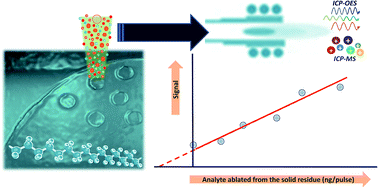当前位置:
X-MOL 学术
›
J. Anal. At. Spectrom.
›
论文详情
Our official English website, www.x-mol.net, welcomes your
feedback! (Note: you will need to create a separate account there.)
Quantitative elemental analysis of polymers through laser ablation – inductively coupled plasma by using a dried droplet calibration approach, DDCA
Journal of Analytical Atomic Spectrometry ( IF 3.1 ) Pub Date : 2018-04-26 00:00:00 , DOI: 10.1039/c8ja00055g Ángela Villaseñor 1, 2, 3, 4 , Marina Boccongelli 5, 6, 7 , José Luis Todolí 1, 2, 3, 4
Journal of Analytical Atomic Spectrometry ( IF 3.1 ) Pub Date : 2018-04-26 00:00:00 , DOI: 10.1039/c8ja00055g Ángela Villaseñor 1, 2, 3, 4 , Marina Boccongelli 5, 6, 7 , José Luis Todolí 1, 2, 3, 4
Affiliation

|
The so-called Dried Droplet Calibration Approach (DDCA) was applied for the first time to the determination of elemental concentration in polyethylene and polypropylene samples by means of inductively coupled plasma optical emission spectrometry (ICP-OES) and mass spectrometry (ICP-MS). Based on this novel calibration strategy, small volumes (c.a., 1 μL) of a series of multielemental aqueous standard solutions were deposited on the sample solid surface. Afterwards, the droplets were dried and a significant fraction of the remaining solid residues (i.e., 80% of their surface area) was ablated. The integrated signals were plotted against the mass of added analyte ablated per laser shot. The analyte concentration in the sample was obtained by extrapolation of the obtained calibration lines. A study demonstrating the existence of matrix effects was carried out, and it was noticed that carbon was not an appropriate internal standard because it did not compensate for changes in the absolute amount of ablated material as a function of the sample matrix. In contrast, elements such as Sc and Y mitigated this effect. External calibration using a polymeric support also proved to be inefficient from the point of view of accuracy. In contrast, the DDCA presented as an outstanding feature the compensation for matrix effects, because with this method both the sample and added standard were simultaneously ablated, and the generated aerosols reached the plasma together. The accuracy of the DDCA was demonstrated by means of the analysis of three polymer certified reference materials. It was verified that, in general terms, there were not significant differences between the elemental certified concentrations and those obtained by applying the DDCA. Furthermore, three polyethylene and three polypropylene samples were analyzed following both the DDCA and a reference method based on acid digestion and further ICP analysis. Both methodologies provided similar results for Al, Ti, Si, Cr, Ca, Zn and Mg. For elements either potentially volatile or present at low concentrations such as As, Hg and Ti in some polymers, there were significant discrepancies between certified and measured values.
中文翻译:

通过激光烧蚀对聚合物进行定量元素分析–使用干滴校准法DDCA感应耦合等离子体
首次使用所谓的干滴定标法(DDCA)通过电感耦合等离子体发射光谱(ICP-OES)和质谱(ICP-MS)测定聚乙烯和聚丙烯样品中的元素浓度。基于这种新颖的校准策略,将少量(大约1μL)的一系列多元素水溶液标准溶液沉积在样品固体表面上。然后,将液滴干燥,并保留大部分剩余的固体残留物(即,其表面积的80%)被烧蚀了。相对于每次激光烧蚀烧蚀的添加分析物质量绘制积分信号。通过外推获得的校准线获得样品中分析物的浓度。进行了一项研究,证明存在基体效应,并且注意到碳不是合适的内标,因为碳不能补偿烧蚀材料的绝对量随样品基体的变化。相反,诸如Sc和Y的元素减轻了这种影响。从准确性的角度来看,使用聚合物载体的外部校准也被证明是低效的。相比之下,DDCA的一项杰出功能是对矩阵效应的补偿,因为使用这种方法,样品和添加的标准品都被同时烧蚀,并且产生的气溶胶一起到达血浆。DDCA的准确性通过对三种聚合物认证参考材料的分析得以证明。经证实,一般而言,元素认证浓度与使用DDCA所获得的浓度之间没有显着差异。此外,按照DDCA和基于酸消解和进一步ICP分析的参考方法,对三个聚乙烯和三个聚丙烯样品进行了分析。两种方法对于Al,Ti,Si,Cr,Ca,Zn和Mg都提供了相似的结果。对于某些聚合物中可能具有挥发性或低浓度的元素(例如As,Hg和Ti),
更新日期:2018-04-26
中文翻译:

通过激光烧蚀对聚合物进行定量元素分析–使用干滴校准法DDCA感应耦合等离子体
首次使用所谓的干滴定标法(DDCA)通过电感耦合等离子体发射光谱(ICP-OES)和质谱(ICP-MS)测定聚乙烯和聚丙烯样品中的元素浓度。基于这种新颖的校准策略,将少量(大约1μL)的一系列多元素水溶液标准溶液沉积在样品固体表面上。然后,将液滴干燥,并保留大部分剩余的固体残留物(即,其表面积的80%)被烧蚀了。相对于每次激光烧蚀烧蚀的添加分析物质量绘制积分信号。通过外推获得的校准线获得样品中分析物的浓度。进行了一项研究,证明存在基体效应,并且注意到碳不是合适的内标,因为碳不能补偿烧蚀材料的绝对量随样品基体的变化。相反,诸如Sc和Y的元素减轻了这种影响。从准确性的角度来看,使用聚合物载体的外部校准也被证明是低效的。相比之下,DDCA的一项杰出功能是对矩阵效应的补偿,因为使用这种方法,样品和添加的标准品都被同时烧蚀,并且产生的气溶胶一起到达血浆。DDCA的准确性通过对三种聚合物认证参考材料的分析得以证明。经证实,一般而言,元素认证浓度与使用DDCA所获得的浓度之间没有显着差异。此外,按照DDCA和基于酸消解和进一步ICP分析的参考方法,对三个聚乙烯和三个聚丙烯样品进行了分析。两种方法对于Al,Ti,Si,Cr,Ca,Zn和Mg都提供了相似的结果。对于某些聚合物中可能具有挥发性或低浓度的元素(例如As,Hg和Ti),











































 京公网安备 11010802027423号
京公网安备 11010802027423号